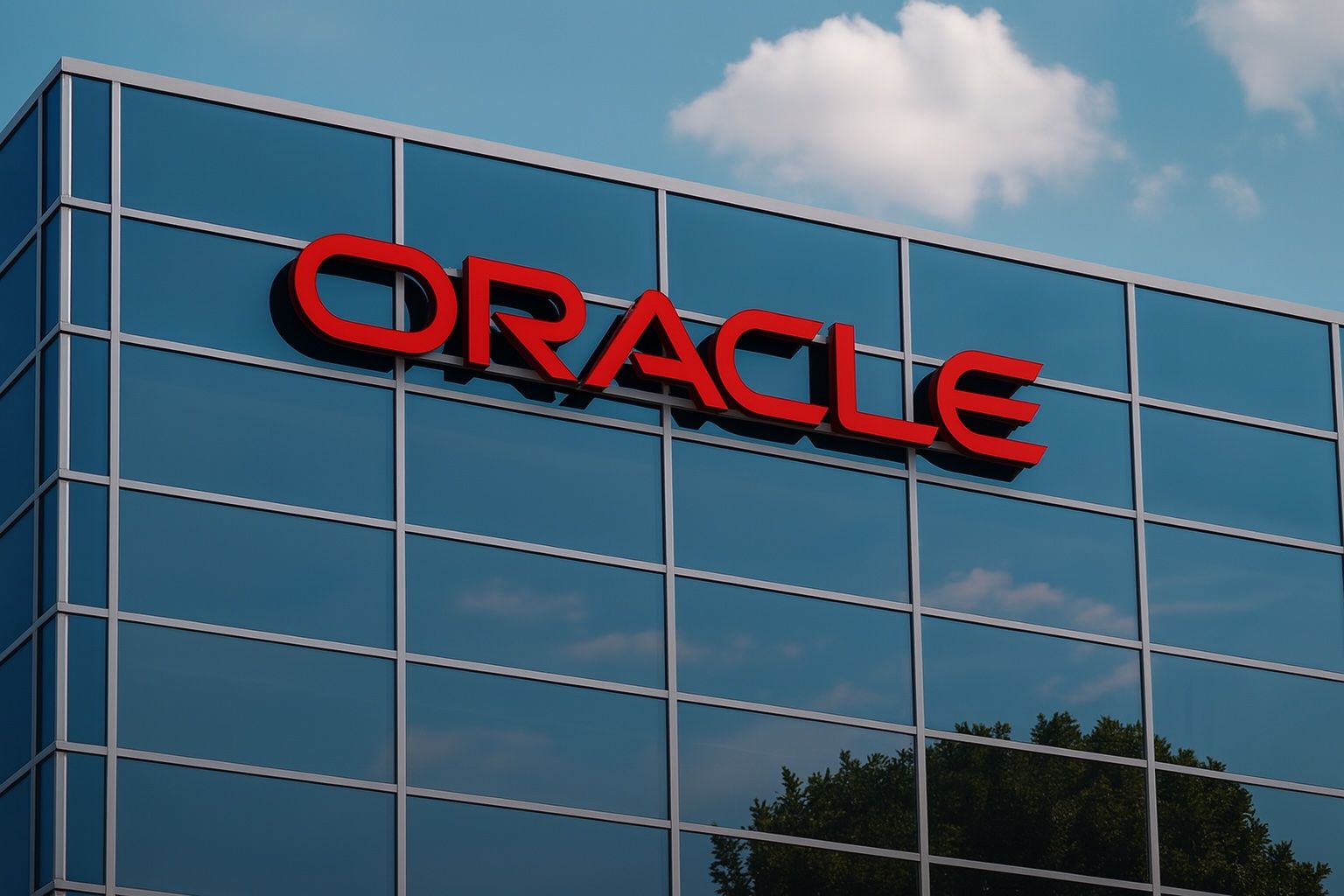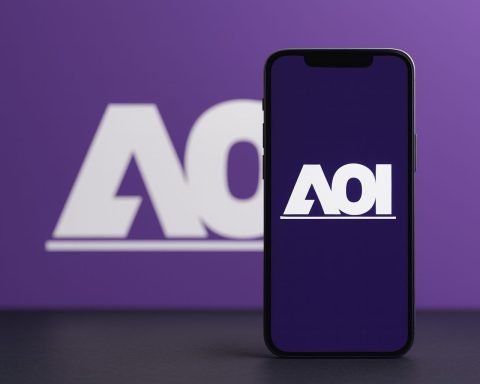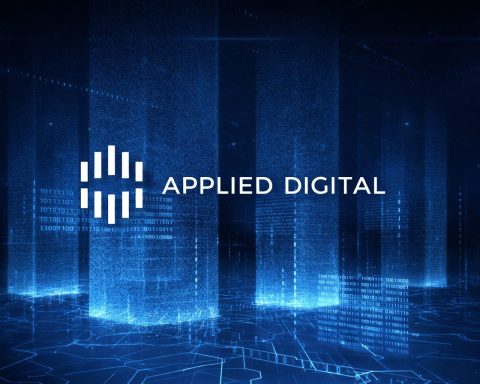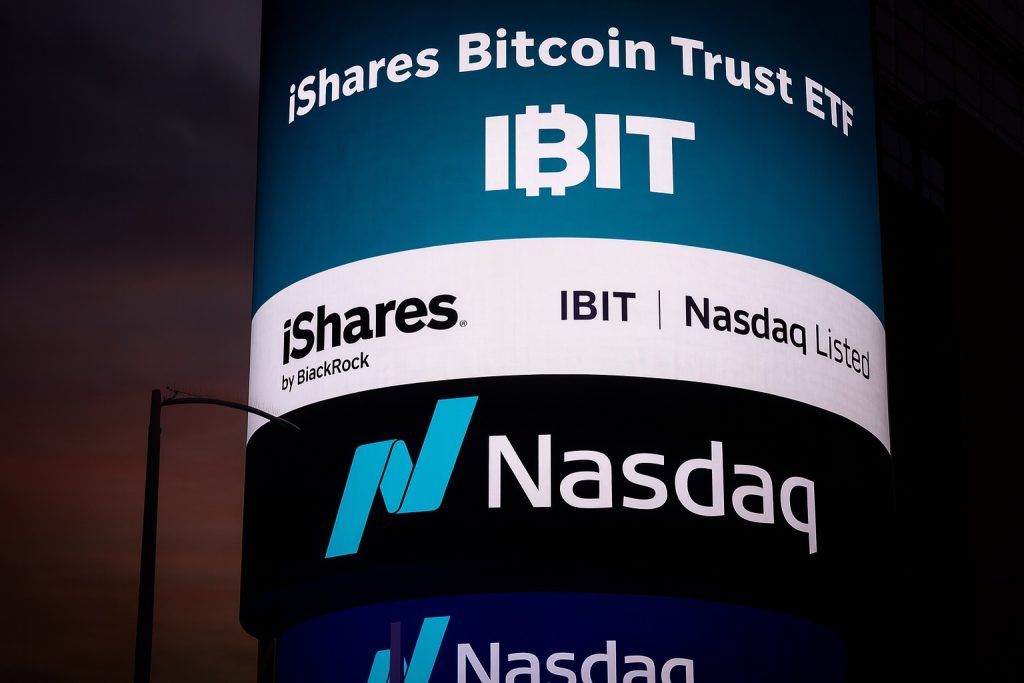- Soaring Stock on AI Boom: Oracle (NYSE: ORCL) shares have nearly doubled in 2025 amid surging demand for its cloud services fueled by artificial intelligence (AI) workloads. The stock spiked ~36% in a single day after Oracle’s early September earnings report revealed an unprecedented jump in cloud contract bookings [1]. As of early October 2025, ORCL trades around $285 per share (market cap ~$820 billion), up ~70% year-to-date, though it remains below its mid-September peak. Oracle’s valuation is now stretched at ~57–67× earnings, far above peers [2] [3].
- Record-Breaking Cloud Deals: Oracle stunned the tech industry by signing several mega cloud contracts tied to AI. Most notably, OpenAI agreed to spend a staggering $300 billion over five years on Oracle Cloud starting in 2027 [4]. This deal – one of the largest in tech history – added $317 billion to Oracle’s remaining performance obligations (backlog) in one quarter [5]. Oracle is also reportedly negotiating a $20 billion+ cloud infrastructure pact with Meta (Facebook’s parent) to power Meta’s AI ambitions [6]. In Q1 FY2026, Oracle signed four multi-billion-dollar cloud contracts (including deals with OpenAI, Meta, and Elon Musk’s xAI) that drove its cloud backlog up 359% year-over-year to $455 billion [7] [8].
- Financial Momentum vs. Heavy Investment: Oracle’s fiscal Q1 2026 (quarter ended Aug. 31, 2025) saw cloud revenue jump 28% (Infrastructure-as-a-Service +55%) and total revenue up 12% to $14.9 billion [9]. Management issued jaw-dropping guidance, predicting Oracle Cloud Infrastructure revenue will grow 77% this fiscal year to $18 billion and reach $144 billion by FY2030 [10] – far above prior estimates. To fulfill these contracts, Oracle is ramping capital expenditures dramatically and tapped debt markets: it spent $8.5 billion on CapEx in Q1 (vs $2.3B a year prior) and raised $18 billion in bonds in September to fund data center build-outs [11] [12]. Oracle’s long-term debt now tops $100 billion [13], prompting some warnings about leverage and execution risk.
- Bull vs. Bear Outlook: Optimism abounds that Oracle could be the next trillion-dollar tech company. Bulls argue Oracle has transformed from a legacy database vendor into an AI cloud leader, with competitive advantages in high-performance cloud infrastructure and cost efficiency for AI workloads [14] [15]. Analysts note Oracle’s cloud backlog now eclipses that of larger rivals, reflecting a “seismic shift” toward AI-centric cloud deals [16]. However, skeptics highlight that Oracle’s “astonishing” growth is highly concentrated in a few AI customers [17]. A Redburn analyst recently warned the market is “overestimating” Oracle’s AI deal value and set a $175 price target (−38%), arguing Oracle will need to borrow ~$100 billion over four years to deliver on the OpenAI contract [18] [19]. Questions remain whether clients like OpenAI can fully utilize and pay for such massive capacity [20], leaving Oracle exposed if the AI boom cools.
- Strategic Partnerships & Competition: Oracle is aggressively partnering across the industry rather than going it alone. It inked a cross-cloud deal with Google to host Google’s upcoming Gemini AI models on Oracle Cloud, so customers can run Google’s advanced AI within Oracle’s environment [21]. Oracle also expanded ties with IBM (bringing IBM’s Watsonx AI platform to OCI) [22] and deepened “multi-cloud” links with rivals Amazon AWS and Microsoft Azure – even embedding Oracle databases inside those clouds, which drove a +1,529% surge in Oracle’s multi-cloud database revenue [23]. This collaborative strategy, along with heavy investment in NVIDIA GPU-powered infrastructure, has rapidly elevated Oracle to a top-tier cloud player. Oracle now positions itself as the “fourth cloud” hyperscaler alongside AWS, Azure, and Google – a “dark-horse” AI supercloud contender after years of being dismissed as a cloud laggard [24] [25].
Recent Stock Performance and Valuation Metrics
Oracle’s stock has been on a tear in 2025, dramatically outpacing the broader market thanks to AI cloud enthusiasm. Shares started the year around the $170s and climbed into the high $200s by early October, after an especially explosive move in September. The catalyst was Oracle’s Fiscal Q1 2026 earnings release on Sept. 9, 2025, which revealed an “astonishing” influx of cloud business. Oracle’s remaining performance obligations (RPO) – a backlog of contracted future revenue – ballooned to $455 billion, up 359% from a year prior [26]. This implied Oracle had secured hundreds of billions in new long-term cloud commitments, far beyond expectations. In response, ORCL stock jumped nearly 40% in the next trading session, marking its biggest one-day gain since 1992 [27]. The stock briefly traded above $330, giving Oracle a market capitalization north of $900 billion and vaulting co-founder Larry Ellison (who owns ~42% of Oracle) past Elon Musk as the world’s richest person [28] [29].
Some of that euphoria cooled as analysts and investors digested the news. Oracle’s shares pulled back from their highs, recently settling around $285–$290 per share in early October. At this level, Oracle’s market cap is roughly $820 billion, making it the fifth or sixth largest U.S. company by market value. The stock is up about 70–80% year-to-date (and more than 100% in the past six months), vastly outperforming the S&P 500 and even outpacing many of the vaunted “Magnificent Seven” tech stocks in 2025.
However, the valuation of ORCL has become a point of debate. By conventional metrics, Oracle now looks expensive. Its price-to-earnings ratio (P/E) has spiked due to the stock’s rapid rise. Analysts estimate Oracle trades around 57× forward earnings – a multiple that “appears high” given consensus profit growth of ~22% annually over the next two years [30]. On a trailing basis, Oracle’s P/E is in the mid-60s (around 65–70×), well above the tech sector average. For context, Oracle’s P/E is 80% higher than the median for its industry [31], and significantly richer than cloud peers like Microsoft or Alphabet, which tend to trade in the 25–35× range. Oracle’s price-to-sales ratio is also elevated (around 12× revenue), reflecting high optimism about future growth.
Bulls argue that traditional multiples don’t fully account for Oracle’s unique position in the AI wave – pointing to its $455 billion backlog as evidence of multi-year revenue “locked in.” They note that roughly half of Oracle’s revenue now comes from cloud services (SaaS applications and OCI infrastructure), which grew 28% in the latest quarter [32]. This mix shift toward cloud subscription revenue could justify a higher valuation than Oracle’s legacy software business did. Additionally, Oracle pays a stable dividend ($0.50 per share quarterly) and continues to repurchase shares, though its dividend yield is modest (~0.7%) after the stock’s surge [33].
Bears counter that Oracle’s valuation already prices in years of growth that must still materialize. At ~57× forward earnings, Oracle is more expensive than even most high-growth megacaps. Moreover, Oracle’s balance sheet leverage is rising – the company ended Q1 with over $100 billion in total debt after a large September bond sale [34] – which could constrain shareholder returns (through higher interest costs). The coming quarters will be critical for Oracle to prove it can convert its massive backlog into actual revenue and earnings, thereby “growing into” its valuation.
Key News and Developments (Late September – Early October 2025)
In the first week of October 2025, Oracle made headlines on several fronts – from groundbreaking AI deals to security incidents:
- $300 Billion OpenAI Cloud Contract: In late September, news broke (via Wall Street Journal and others) that OpenAI signed a five-year, $300 billion cloud computing contract with Oracle [35]. OpenAI – the AI lab behind ChatGPT – will reportedly start using Oracle’s cloud in 2027, ultimately consuming about 4.5–5 gigawatts of capacity (roughly 2 million high-end GPU servers) over the term [36]. This colossal deal, part of the “Project Stargate” initiative, dwarfs typical cloud contracts and underscores the insatiable demand for AI computing power. Oracle confirmed in its earnings call that this OpenAI agreement was a major driver of its Q1 backlog spike [37] [38]. The contract’s scale is “historic” – at $60 billion per year, it’s on par with the annual revenue of Oracle itself and exceeds the GDP of many countries [39]. OpenAI and its backers (including SoftBank) have raised new funding to help finance this commitment [40]. Still, the deal raised eyebrows about feasibility and risk: OpenAI is not yet profitable and doesn’t currently generate anywhere near $60B/year in revenue [41]. Oracle acknowledges the “AI bubble” concerns but maintains that most of the revenue from this contract is locked in via long-term agreements [42] [43].
- Oracle–Meta $20B Cloud Alliance (Rumored): Around the same time, reports emerged that Oracle is in advanced talks with Meta Platforms on a cloud partnership valued around $20 billion over multiple years [44]. Meta (the parent of Facebook, Instagram, and WhatsApp) is aggressively expanding its AI capabilities – planning massive GPU supercomputers and openly sharing its Llama AI models. Meta already uses multiple clouds (it has a $10B deal with Azure/♾ and significant in-house data centers) but needs more capacity to train next-gen AI models [45] [46]. The prospective Oracle–Meta deal would have Oracle provide cloud infrastructure for Meta’s AI workloads, complementing Meta’s existing cloud providers [47]. When news of these talks surfaced, Oracle’s stock jumped ~4% intraday [48], as investors saw it as further validation of Oracle’s strategy. Oracle’s newfound credibility in AI even briefly propelled Larry Ellison past Elon Musk in net worth, highlighting how transformative such deals could be [49]. Note: As of Oct 6, 2025, the Meta deal is not officially confirmed – but industry watchers say the commitment could grow even larger as negotiations continue [50].
- Fiscal Q1 Earnings Highlights: Oracle’s Q1 FY2026 results (announced Sept. 9) set the stage for these developments. Quarterly revenue was $14.9B (+12% YoY), with cloud services (IaaS + SaaS) at $7.2B (+28%) [51]. Notably, Cloud Infrastructure (OCI) revenue jumped 54% YoY to $3.3B [52], while Cloud Applications (Fusion ERP, NetSuite, etc.) grew ~11%. Oracle’s legacy software licensing business was flat to slightly down [53] – underscoring that cloud is now the growth engine. Profit-wise, Q1 non-GAAP EPS was $1.47 (+6%), a bit above forecasts, though GAAP EPS was slightly down due to higher investment and acquisition costs [54] [55]. The shocker was Oracle’s remaining performance obligation (RPO) hitting $455B [56], up from just $99B a year prior [57]. CEO Safra Catz highlighted: “We signed four multi-billion-dollar contracts with three different customers in Q1… It was an astonishing quarter – and demand for Oracle Cloud Infrastructure continues to build. Over the next few months, we expect to sign several additional multi-billion-dollar customers and RPO is likely to exceed half-a-trillion dollars.” [58]. Oracle’s forward guidance also stunned Wall Street: Catz projected OCI revenue growth of 77% this fiscal year, and laid out a five-year cloud revenue trajectory reaching $144B by FY2030 [59]. Such bullish forecasts – unprecedented for a company Oracle’s size – contributed to the stock’s big jump. Oracle’s leadership essentially signaled that a new era of growth is underway, driven by AI cloud megadeals.
- Bond Issuance and Capital Spending: To support this rapid expansion, Oracle is pouring money into infrastructure. In late September, Oracle sold $18 billion of corporate bonds, one of its largest debt raises ever [60]. Investor appetite was huge (orders reportedly neared $88B for the offering) – a vote of confidence in Oracle’s plan [61]. The proceeds will help fund a wave of new Oracle Cloud data centers and hardware (primarily NVIDIA GPU clusters) to fulfill contracts like OpenAI’s. KeyBanc Capital Markets analysts estimate Oracle may need to invest on the order of $25 billion per year for the next four years – roughly $100B total – in data center build-out to meet its obligations [62]. Oracle’s Q1 free cash flow turned negative due to a ~270% YoY jump in CapEx (from $2.3B to $8.5B) [63]. Oracle ended the quarter with about $10B in cash vs $82B long-term debt (pre-bond sale) and ~$9B in short-term debt [64]. Credit agency Moody’s has raised concerns about Oracle’s debt-fueled expansion, warning of “counterparty risk” – i.e. if OpenAI or others can’t pay their sky-high cloud bills, Oracle could be left holding the bag. Nonetheless, Oracle argues these investments will pay off over time, given its record $455B backlog. The company notes most of the 5-year revenue forecast it gave is already under contract in the RPO [65].
- Security Breach and Zero-Day Patch: On a less celebratory note, Oracle faced a cybersecurity issue in early October. On Oct 6, Oracle disclosed and patched a critical zero-day vulnerability (CVE-2025-61882) in its widely used E-Business Suite (EBS) enterprise software [66]. The flaw, rated 9.8/10 in severity, allows remote code execution without login – and was actively exploited by the Clop ransomware gang [67] [68]. Oracle admitted that hackers had been using this unknown bug, as well as older unpatched bugs, to steal data from some EBS customers and attempt extortion [69] [70]. The Clop group reportedly sent extortion emails to executives at targeted firms, claiming to have stolen sensitive data from Oracle EBS systems [71]. Oracle’s Chief Security Officer acknowledged the issue last week, warning customers of possible breaches and urging them to apply patches [72]. By Oct 6, Oracle rushed out an emergency fix for the zero-day over the weekend [73]. Cybersecurity firm Mandiant confirmed “mass exploitation” of the flaw had already occurred in August, potentially impacting multiple organizations [74] [75]. While there’s no sign this incident directly compromises Oracle’s cloud infrastructure, it is a reputational concern, reminding that even enterprise giants like Oracle face security challenges. Oracle will likely bolster its security efforts and incident response given the high-profile nature of the attack. So far, the market has largely shrugged off the incident (Oracle’s stock was flat to slightly down on the news), as investors remain focused on the company’s AI-driven growth story.
Oracle’s Business Outlook: Bullish Catalysts vs. Caution Flags
Oracle’s recent moves have drawn both exuberant praise and cautious skepticism from experts. Here is a look at the bull case and bear case on ORCL stock and the company’s trajectory:
Bull Case – Oracle as AI Cloud Champion: Many analysts now view Oracle as an unexpected leader in the AI computing boom. The Q1 results prompted shocked reactions on Wall Street – one observer called Oracle’s growth “truly historic” [76]. Oracle has convincingly shaken off its old image as a slow-growth legacy vendor and is instead seen as a primary beneficiary of the “AI arms race” in cloud computing. With its backlog swelling to levels exceeding even Amazon’s or Microsoft’s, Oracle appears positioned to deliver years of robust growth. Consensus forecasts have been raised: analysts now predict Oracle’s overall revenue will climb ~17% in FY2026 and accelerate to ~22% in FY2027 [77] – a dramatic step-up from the 9–12% growth rates of recent years. If those targets are met, Oracle would far outpace the broader IT industry growth. This momentum has led to speculation that Oracle could be the first new entrant into the $1 trillion market cap club in this AI-driven cycle. “The next tech stock in line to achieve this milestone is Oracle, a company that may come as a surprise to many investors,” wrote one analyst, noting Oracle briefly hit $900B and has “the catalysts needed to exceed the $1 trillion mark as it reemerges as a force in the AI industry.” [78]
Proponents argue Oracle’s strategy is sound and differentiating. Rather than trying to out-spend Amazon or Microsoft across the board, Oracle focused on a niche it could win – high-performance cloud infrastructure for AI, and database services across multiple clouds. By offering lower-cost, ultra-fast GPU computing and letting customers “burst” between Oracle Cloud and other clouds, Oracle is carving out a reputation for price-performance leadership in AI workloads [79] [80]. Even competitors privately acknowledge Oracle’s GPUs are cheaper and more readily available for AI training jobs in the current environment. Oracle’s ability to secure marquee clients like OpenAI, Meta, and Zoom (which chose Oracle Cloud for critical workloads in 2020) boosts its credibility. Larry Ellison has fully embraced the AI opportunity – after once calling cloud computing “gibberish,” the 81-year-old Oracle CTO now proclaims “AI changes everything” for Oracle’s business [81]. Oracle is also leveraging its enterprise software strengths: for example, it’s building an “Oracle AI Database” service (previewed at Oracle’s AI World conference) that will let customers apply AI models like OpenAI’s GPT or Google’s Gemini directly to data stored in Oracle databases [82]. This could be a killer feature for Oracle’s huge base of database and ERP customers, knitting together its traditional products with new AI capabilities.
From a stock perspective, bulls note that Oracle’s total return has already been impressive – up over 380% in the past five years [83] – yet many investors only recently appreciated its transformation. Some on Wall Street see further upside: the most optimistic analyst price targets approach $400 [84], implying ~40% gain from current levels. Pro-Oracle analysts argue that while the stock’s valuation is rich, it is justified by Oracle’s growth potential and backlog visibility. A Barchart report, for instance, concluded that “Oracle’s momentum is far from over… [its] long-term growth trajectory justifies the premium” [85] [86]. If Oracle can execute on even a portion of its huge RPO, it will generate significantly higher revenues, which could bring down its P/E multiple over time. Furthermore, Oracle’s move into the top tier of cloud providers may invite a valuation more comparable to hyperscaler peers (e.g. Microsoft, which trades at ~11× sales vs. Oracle ~12×). In short, the bull case posits that Oracle is in the early innings of an AI-driven growth super-cycle, and those who buy in now are effectively betting on Oracle becoming a dominant cloud+AI platform over the next decade.
Bear Case – Overhyped and Overleveraged: Despite the impressive headlines, some experts urge caution on Oracle. A key concern is that Oracle’s historic backlog surge relies overwhelmingly on a single customer (OpenAI) and a few others. Nearly $300B of the $317B sequential increase in RPO last quarter came from OpenAI’s contract [87]. That concentration is risky: “analysts quickly warned that almost all of Oracle’s surge came from this one client – a concentration risk if OpenAI can’t pay or switches providers,” as one recap noted [88]. OpenAI is essentially a startup (albeit a well-funded one) with uncertain long-term revenue. If AI demand doesn’t grow as explosively as expected, or if OpenAI fails to monetize its products to cover a $60B/yr cloud bill, Oracle could face an ugly scenario: building out vast data centers but not getting paid in full. This would leave Oracle with massive unused capacity (and debt). Moody’s and other analysts have explicitly flagged this “too good to be true” scenario in recent weeks [89]. Notably, after the initial euphoria, Oracle’s stock gave back about 7% as the market digested these realities [90].
Beyond OpenAI, Oracle’s other hyped deals also have question marks. The rumored Meta deal, while big, is not done yet – it could fall apart or be delayed. Oracle’s deal with Elon Musk’s xAI (an AI startup) is reportedly smaller, but details are scarce [91]. It’s unclear how much of Oracle’s backlog is tied to financially strong customers versus speculative ventures. Short-sellers point out that Oracle’s backlog could evaporate if these AI projects under-deliver [92]. For example, if OpenAI or xAI decide to scale down their compute usage (or go to a different provider), Oracle might end up revising its rosy forecasts.
Another issue is the profitability and cash flow impact of Oracle’s push. To secure business, Oracle may be offering cut-rate pricing on cloud services (essentially trading margin for growth). Oracle’s cloud gross margins are likely well below those of AWS or Azure currently, given the heavy investment phase. Additionally, Oracle’s debt load is ballooning: it has taken on about $35B in new debt in the past two years (including the recent $18B bond) to fund acquisitions (like Cerner in 2022) and now data centers [93]. Oracle’s net debt to EBITDA ratio has risen, and interest expense will climb. If the economy turns or credit markets tighten, Oracle could be in a vulnerable spot with over $100B debt – highly unusual for a company its size (Microsoft, for instance, has under $50B debt). One analyst, Alex Haissl of Redburn, made waves on Sept. 26 by issuing a rare “Sell” on Oracle, arguing that “the market is overestimating the value of the OpenAI deal and ignoring potential risks”. He described Oracle’s current scenario as a “risky ‘blue sky’” situation and set a price target of $175 (implying ~38% downside) [94] [95]. Haissl believes Oracle’s stock (up ~70% in 2025 at that point) had gotten far ahead of fundamentals. After his call, Oracle’s stock dropped over 5% in two days [96], suggesting some investors share these worries.
Valuation is the final sticking point for bears. At ~60× earnings, Oracle is priced for perfection. Any misstep – an earnings miss, a deal cancellation, slower-than-promised growth, or broader market rotation out of tech – could trigger a sharp correction. The stock’s high multiple also means it has little margin for error if interest rates stay high (future profits are less valuable in a high-rate environment). Some skeptics say there are better AI plays with less baggage: “Since [the Magnificent Seven] offer lower valuations and safer balance sheets, such stocks are likely more prudent choices for investors than Oracle,” one commentator wrote, after acknowledging Oracle’s AI potential [97]. In other words, why buy Oracle at 60× earnings and ~<1% yield when one could buy Microsoft at ~30× with a fortress balance sheet, unless one truly believes Oracle will sustain much higher growth?
Bottom Line: The truth may lie between the extremes. Oracle undoubtedly has renewed growth momentum and a bold plan to reinvent itself as an AI-centric cloud provider. The next couple of quarters will be telling. Investors will be watching if Oracle can continue to land new big customers (Catz indicated more “multi-billion dollar” deals could be signed within months [98]) and whether initial revenue from these huge contracts starts to flow as projected. Any updates on the Meta deal or other partnerships could be catalysts as well. On the other hand, signs of hesitation – if, say, Oracle’s cloud revenue growth falls short of that 77% target or if capital costs escalate – would raise questions about the viability of its aggressive forecast.
Strategic Developments: Acquisitions, Partnerships, and Product Launches
Oracle’s recent strategy can be characterized by deep partnerships and targeted bets rather than large traditional acquisitions. In the past, Oracle grew via big acquisitions (PeopleSoft, Sun Microsystems, NetSuite, etc.), but in the last couple of years it has pivoted to focusing on cloud infrastructure expansion and alliances in the AI realm:
- Cloud Partner Ecosystem: Oracle is actively partnering even with erstwhile competitors. In a noteworthy cross-cloud initiative, Oracle and Google announced a collaboration to integrate Google’s “Gemini” AI models into Oracle Cloud Infrastructure (OCI) [99]. This means Oracle Cloud customers will eventually be able to leverage Google’s latest multimodal AI (which is a rival to OpenAI’s models) within Oracle’s cloud services. Similarly, Oracle has worked with Microsoft to interconnect OCI with Azure (the two clouds have a direct interconnect and identity federation, easing hybrid deployments). Oracle’s database products are now offered in the Oracle Database Service for Microsoft Azure, allowing Azure users to tap Oracle’s database on OCI with a seamless experience – part of Oracle’s push to make its technology ubiquitous in multi-cloud environments. With Amazon, Oracle achieved a milestone by making its flagship Oracle Database available on AWS as a fully managed service, and by setting up Oracle Cloud regions inside AWS data centers for low-latency connectivity [100]. These moves acknowledge that many enterprises use multiple clouds; Oracle is positioning itself not as a walled garden but as an “open” cloud that plays nicely with others, which is somewhat unique among the big providers.
- Enterprise Software & AI Integration: Oracle has continued updating its enterprise application suite (Fusion ERP, HCM, NetSuite, etc.) but the standout theme is integrating AI features. Oracle’s upcoming “AI Database” (expected to be unveiled at Oracle’s AI World conference) is one such innovation – it will let Oracle database users apply various large language models (from OpenAI’s GPT-4 to emerging models like xAI’s “Grok”) on their company data directly within the database [101]. This could greatly simplify building AI-powered apps on top of Oracle databases, a huge installed base. Oracle is also embedding generative AI into its business software: e.g., adding AI assistants in its cloud ERP and CX (customer experience) tools to automate tasks like financial reconciliations or marketing content generation. The company’s 2022 acquisition of Cerner (healthcare IT) is being leveraged to apply AI in healthcare operations and medical record analytics, though Cerner’s integration has been challenging. To bolster its AI capabilities, Oracle made strategic investments in AI startups like Cohere (which builds language models). Oracle now offers Cohere’s large language models on OCI for customers who want an alternative to OpenAI [102]. Unlike Microsoft or Google, Oracle is not designing its own AI chips; instead it has forged a close partnership with NVIDIA and AMD to use the latest GPU and CPU chips in its cloud [103]. Oracle’s bet is that being hardware-agnostic but early to adopt the best chips (like NVIDIA’s H100 GPUs) in massive quantities will attract AI developers.
- Industry Cloud Solutions & Clients: Oracle has pursued industry-specific cloud solutions, which has helped land big customers. For example, Oracle and Cleveland Clinic partnered on a healthcare platform (with backing from G42, an Abu Dhabi AI firm) to host medical data for research [104]. Oracle’s cloud also won deals in telecommunications (e.g. with Zoom in 2020 for video conferencing cloud capacity, and more recently with Telcos for 5G network cores). In a notable recent win, Oracle is assisting the Chinese e-commerce company Temu in establishing operations in the U.S., indicating Oracle cloud’s appeal to fast-growing digital companies [105]. Oracle’s ability to offer hybrid cloud appliances (like Oracle Exadata Cloud@Customer for on-premise use) and its reputation for security and performance in handling mission-critical workloads give it an edge in courting large enterprises and government sectors that require both cloud and on-premise continuity.
- No Major M&A (For Now): Aside from the $28B Cerner deal (closed in 2022) and some smaller cloud-native security and developer tool acquisitions, Oracle has not announced any huge acquisitions in 2024 or 2025 to date. Instead, it appears to be channeling capital into organic growth (data centers, engineering) and partnerships. One exception is that Oracle has hinted it would consider “tuck-in” acquisitions in cloud or AI if advantageous. Some analysts speculated Oracle could eye an AI software company or a cybersecurity firm to complement its cloud (for example, something in the identity management space, since Oracle has a legacy there). But with Oracle’s plate full integrating massive new cloud customers, big M&A is likely on the back burner. Notably, Oracle’s own R&D spend has been climbing (Oracle touts over $9B annually in R&D, some of which goes into AI). The company claims to have spent over $90B on R&D since 2012 and $110B on acquisitions in that time [106], indicating it is no stranger to heavy investment.
In summary, Oracle’s strategic posture in 2025 is centered on expanding its cloud footprint aggressively and embedding itself in the AI ecosystem through partnerships. This approach is markedly different from even a few years ago when Oracle was seen as insular. It reflects Oracle’s recognition that to compete with AWS, Azure, and Google, it must offer something different – whether that’s better performance/price for AI, or the ability to work across clouds seamlessly, or unique software tied to its cloud. Thus far, this strategy has yielded headline-grabbing wins (OpenAI, etc.) and a resurgence in Oracle’s market relevance.
Market Positioning and Competition
Oracle’s emergence as a major cloud player comes as the “Big Three” cloud providers (Amazon AWS, Microsoft Azure, Google Cloud) are themselves racing to scale up for AI. This has set the stage for intense competition, but also some cooperation, in the cloud market:
- Cloud Market Share: Traditionally, Oracle was a distant player in cloud infrastructure. AWS, Azure, and Google have long dominated with roughly 65%+ combined market share [107]. Oracle’s share was in the low single digits. However, with the recent deals, Oracle’s booked future business (backlog) has suddenly leapfrogged to the top. Oracle now boasts the largest reported cloud contract backlog in the industry at $455B [108] – surpassing even AWS’s ~$195B backlog (which is mostly multi-year enterprise contracts) [109]. This is an eye-catching statistic, though it’s not apples-to-apples: AWS’s revenue (over $30B per quarter [110]) still vastly exceeds Oracle’s ($3.3B per quarter in IaaS [111]). The backlog figure indicates Oracle has enormous demand lined up, but it will take years to convert that to actual revenue. If Oracle executes, its market share in cloud could rise substantially by late this decade. Industry analysts now legitimately talk about the “fourth hyperscaler” or “Supercloud” – referring to Oracle joining AWS, Microsoft, Google in the top tier [112]. “The OpenAI–Oracle pact positions Oracle as a ‘Fourth Cloud’ alongside AWS, Azure, and Google – a dark-horse contender in the AI era,” noted Tech Space 2.0 [113]. This is a remarkable turnaround for Oracle, which spent much of the 2010s being underestimated in cloud.
- Competitive Differentiators: Oracle’s competitive strategy centers on performance, cost, and multi-cloud capability. Its OCI data centers were built relatively late, which means Oracle was able to design them specifically for modern AI and data workloads (e.g. high-bandwidth networking between GPU servers, and a custom operating system for optimal I/O). Oracle claims this allows OCI to offer 40%+ lower cost per unit of GPU compute compared to AWS or Azure – a key reason cost-sensitive AI startups have gravitated to OCI [114] [115]. Additionally, Oracle’s concept of bringing Oracle tech into other clouds (as seen with the Oracle Database running inside Azure/AWS) turns competition into coopetition. It lets customers use e.g. Azure’s AI services while Oracle quietly provides the database or infrastructure under the hood (and Oracle still gets paid). This “embedded Oracle” approach has driven that astounding +1529% multi-cloud database revenue growth in Q1 [116], reflecting usage via Amazon, Google, and Microsoft partnerships. No other major cloud vendor has achieved such deep integration into rivals’ platforms. Oracle’s longstanding enterprise relationships also give it an edge in selling full-stack solutions – for instance, bundling an Oracle SaaS application with OCI cloud credits.
- Competitors’ Moves: Oracle’s rivals aren’t standing still. Amazon Web Services remains the market leader and is also investing massively in AI: AWS’s backlog grew 25% to $195B recently [117], and Amazon said it plans to spend $100B on capex in 2025, largely on data centers and custom AI chips (like its Trainium and Inferentia silicon) [118]. AWS has announced its own large language model (Bedrock service) and partnerships (Anthropic, etc.), aiming to keep AI workloads on AWS. Microsoft Azure is bolstered by its unique OpenAI partnership (Microsoft invested $10B in OpenAI and is the primary cloud for OpenAI until 2026) [119]. Azure reported ~39% revenue growth and is pouring a record $30B in capex in a single quarter to add server capacity [120] – evidence of extraordinary AI demand straining even Microsoft’s infrastructure. Google Cloud saw ~32% growth and notably secured a $10B, 6-year deal with Meta in early 2023 to supply AI compute [121] [122]. Google also offers its own cutting-edge AI (TPU chips, Vertex AI platform) and is pushing multi-cloud tools like Anthos. In summary, all the giants are in an arms race to build AI supercomputers for clients, and Oracle has boldly joined this race. While Oracle’s cloud revenue today is smaller, its ambition and growth rate now rival competitors. As one industry analysis put it, “Oracle’s backlog now eclipses all rivals, underscoring a industry ‘seismic shift’ toward AI-focused cloud deals.” [123]
- Enterprise Software Competition: Outside of infrastructure, Oracle still competes in enterprise software (databases, ERP, etc.) against the likes of SAP, Microsoft, Salesforce, IBM. In databases, Oracle’s flagship remains dominant for high-end transactional systems, but cloud-based databases from Amazon (Aurora) and others are chipping away for new workloads. Oracle’s response has been to offer its Autonomous Database and MySQL HeatWave services on OCI, and notably to make Oracle Database available in multi-cloud form as mentioned. In enterprise applications (ERP, HCM), Oracle Cloud ERP has been gaining share against SAP’s legacy systems, especially with large customers migrating to cloud suites. Oracle reported its Fusion Cloud ERP revenue grew 17% in Q1 and NetSuite (for mid-market) grew 16% [124], suggesting healthy demand as companies modernize back-office systems. Still, this part of Oracle’s business, while steady, is growing much slower than the cloud infra side. The competitive dynamics here are more traditional – Oracle vs SAP in ERP (with Oracle touting wins like an 8x increase in Fusion ERP customers over a few years), and Oracle vs Salesforce in CRM (Oracle’s CX suite vs Salesforce). These battles continue but have been overshadowed in 2025 by Oracle’s cloud infrastructure narrative.
- Market Perception: Oracle’s newfound position has generally improved its standing on Wall Street. A year ago, Oracle was often seen as a value stock – reliable earnings, moderate growth, big buybacks/dividends. Now it’s increasingly viewed as a growth stock tapping into the hottest trends (Cloud, AI). This can be a double-edged sword: expectations are higher, and Oracle faces the task of execution at scale in a way it hasn’t before in cloud. It must convince the market that Q1’s success is not a one-off “AI hype” blip but the start of sustained outperformance. Oracle’s management emphasizes that the AI trend is real and driving a long-term upgrade cycle: “Public cloud spend will increase fourfold over the next three years, largely driven by growing generative AI workloads,” according to an analysis cited by Oracle [125]. If that’s accurate, there may be room for multiple winners, Oracle included. However, if the competitive gap between Oracle and the top 3 clouds narrows, one can expect AWS, Microsoft, and Google to respond aggressively on pricing or incentives to retain key clients. The true test of Oracle’s competitive strength will be whether it can grow its cloud business beyond just a few giant deals – i.e., attracting a broad ecosystem of AI startups and enterprise workloads to OCI. Early signs (like the uptake of Oracle’s Ampere ARM-based cloud instances and new AI services) are encouraging, but the next 12–18 months will be critical for solidifying Oracle’s place in the cloud hierarchy.
Conclusion
As of October 2025, Oracle Corporation stands at an inflection point. The company has surprised critics by securing some of the largest cloud contracts ever seen, galvanizing its stock and putting it within sight of the trillion-dollar valuation club. Oracle’s bold bets on AI infrastructure – the $300B OpenAI deal, potential $20B+ Meta deal, and others – have the potential to transform its growth profile and vault Oracle into the top echelon of technology firms.
However, with great opportunity comes great execution risk. Oracle is effectively wagering huge capital today for revenue that will unfold over the latter half of the decade. Its ability to finance and build out the required capacity without overextending will be closely watched. Investors should expect continued volatility in ORCL stock as news (or rumors) emerges about new deals, project milestones, and the performance of those marquee clients.
For now, Oracle’s message to the market is confident: the company believes it is riding a durable wave of demand as “AI changes everything,” in Ellison’s words [126]. If Oracle delivers on even a portion of the lofty targets it has set – 77% cloud growth this year, $144B cloud revenue by 2030 [127] – it will have successfully reinvented itself for the cloud era and likely rewarded shareholders handsomely. On the other hand, if the AI frenzy cools or Oracle stumbles, the stock’s rich valuation leaves room for a painful correction.
In short, Oracle’s story in late 2025 is one of high-reward but high-risk transformation. The coming quarters will show whether Oracle can firmly capitalize on its “dark-horse” supercloud status and perhaps even achieve the once-unthinkable – joining the trillion-dollar market cap club as a rejuvenated, AI-powered enterprise tech giant.
Sources:
- Oracle FY2026 Q1 Earnings Release [128] [129] (Oracle Investor Relations)
- Yahoo Finance/InsiderMonkey: Analyst caution on Oracle’s valuation [130] [131]
- Motley Fool: “This AI Stock Could Be the First New $1 Trillion Company…” [132] [133]
- Tech Space 2.0: Oracle’s AI cloud deals and market impact [134] [135]; Oracle–Meta deal coverage [136] [137]
- The Register: Oracle’s debt-funded expansion for AI deals [138] [139]; Clop EBS zero-day exploit report [140] [141]
- Channel Futures: Oracle’s $30B cloud customer and partnerships [142] [143]
- Barchart/Inkl: Analysis of Oracle’s stock surge, growth prospects and valuation [144] [145] [146]
- AInvest News: Redburn’s Alex Haissl on Oracle’s “risky blue sky” scenario [147] [148] and context on stock moves [149].
References
1. finviz.com, 2. www.yahoo.com, 3. finviz.com, 4. ts2.tech, 5. ts2.tech, 6. ts2.tech, 7. ts2.tech, 8. ts2.tech, 9. investor.oracle.com, 10. ts2.tech, 11. www.theregister.com, 12. www.theregister.com, 13. www.theregister.com, 14. finviz.com, 15. finviz.com, 16. ts2.tech, 17. ts2.tech, 18. www.ainvest.com, 19. www.ainvest.com, 20. ts2.tech, 21. ts2.tech, 22. www.channelfutures.com, 23. investor.oracle.com, 24. ts2.tech, 25. ts2.tech, 26. ts2.tech, 27. ts2.tech, 28. ts2.tech, 29. ts2.tech, 30. www.inkl.com, 31. www.ainvest.com, 32. finviz.com, 33. investor.oracle.com, 34. www.theregister.com, 35. ts2.tech, 36. ts2.tech, 37. www.theregister.com, 38. www.theregister.com, 39. ts2.tech, 40. ts2.tech, 41. ts2.tech, 42. www.channelfutures.com, 43. www.channelfutures.com, 44. ts2.tech, 45. ts2.tech, 46. ts2.tech, 47. ts2.tech, 48. ts2.tech, 49. ts2.tech, 50. ts2.tech, 51. investor.oracle.com, 52. investor.oracle.com, 53. investor.oracle.com, 54. investor.oracle.com, 55. investor.oracle.com, 56. investor.oracle.com, 57. ts2.tech, 58. investor.oracle.com, 59. ts2.tech, 60. www.ainvest.com, 61. www.ainvest.com, 62. www.theregister.com, 63. www.theregister.com, 64. www.theregister.com, 65. investor.oracle.com, 66. www.theregister.com, 67. www.theregister.com, 68. www.theregister.com, 69. www.theregister.com, 70. www.theregister.com, 71. www.theregister.com, 72. www.theregister.com, 73. www.theregister.com, 74. www.theregister.com, 75. www.theregister.com, 76. ts2.tech, 77. finviz.com, 78. finviz.com, 79. finviz.com, 80. finviz.com, 81. ts2.tech, 82. investor.oracle.com, 83. finviz.com, 84. www.inkl.com, 85. www.inkl.com, 86. www.inkl.com, 87. ts2.tech, 88. ts2.tech, 89. ts2.tech, 90. ts2.tech, 91. ts2.tech, 92. ts2.tech, 93. www.theregister.com, 94. www.ainvest.com, 95. www.ainvest.com, 96. www.ainvest.com, 97. finviz.com, 98. ts2.tech, 99. ts2.tech, 100. investor.oracle.com, 101. investor.oracle.com, 102. ts2.tech, 103. ts2.tech, 104. www.channelfutures.com, 105. www.channelfutures.com, 106. www.oracle.com, 107. ts2.tech, 108. ts2.tech, 109. ts2.tech, 110. ts2.tech, 111. investor.oracle.com, 112. ts2.tech, 113. ts2.tech, 114. finviz.com, 115. finviz.com, 116. investor.oracle.com, 117. ts2.tech, 118. ts2.tech, 119. ts2.tech, 120. ts2.tech, 121. ts2.tech, 122. ts2.tech, 123. ts2.tech, 124. investor.oracle.com, 125. premierstocksleague.com, 126. ts2.tech, 127. ts2.tech, 128. investor.oracle.com, 129. investor.oracle.com, 130. www.ainvest.com, 131. www.ainvest.com, 132. finviz.com, 133. finviz.com, 134. ts2.tech, 135. ts2.tech, 136. ts2.tech, 137. ts2.tech, 138. www.theregister.com, 139. www.theregister.com, 140. www.theregister.com, 141. www.theregister.com, 142. www.channelfutures.com, 143. www.channelfutures.com, 144. www.inkl.com, 145. www.inkl.com, 146. www.inkl.com, 147. www.ainvest.com, 148. www.ainvest.com, 149. www.ainvest.com










